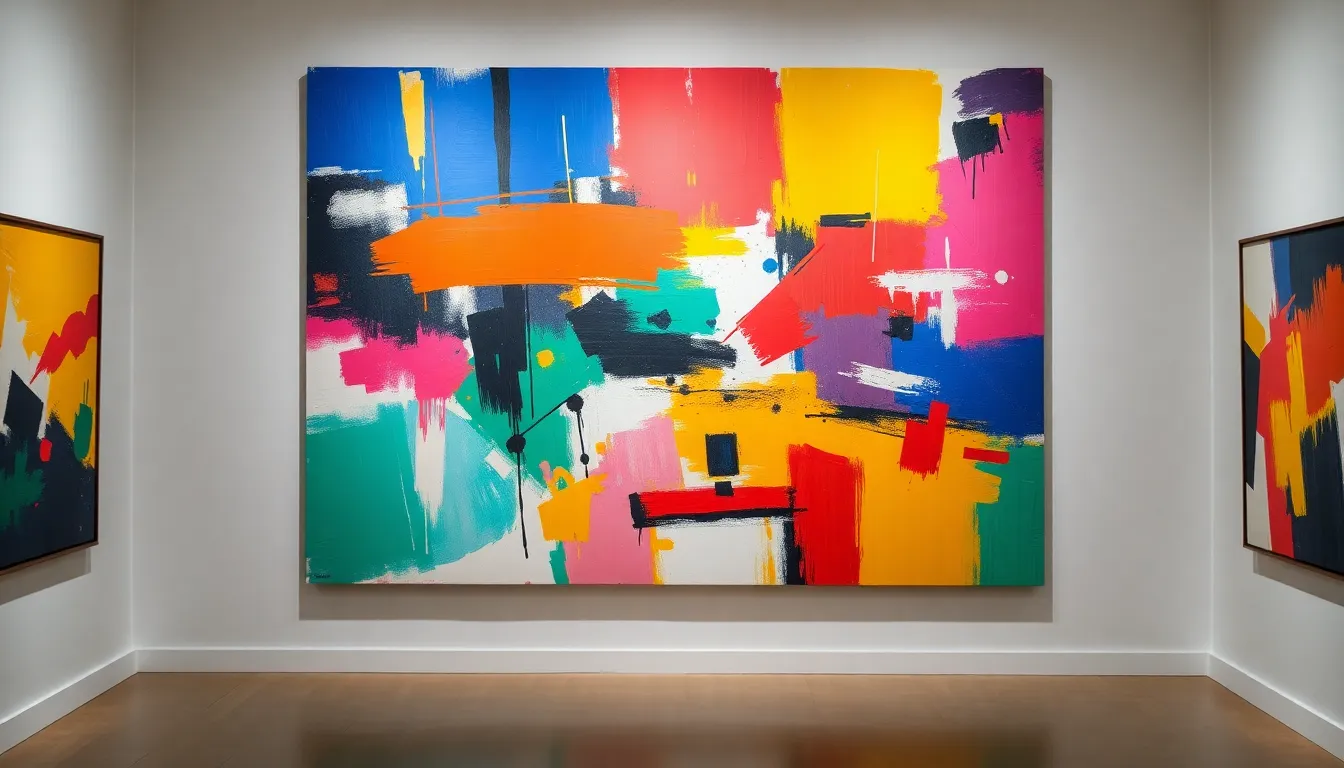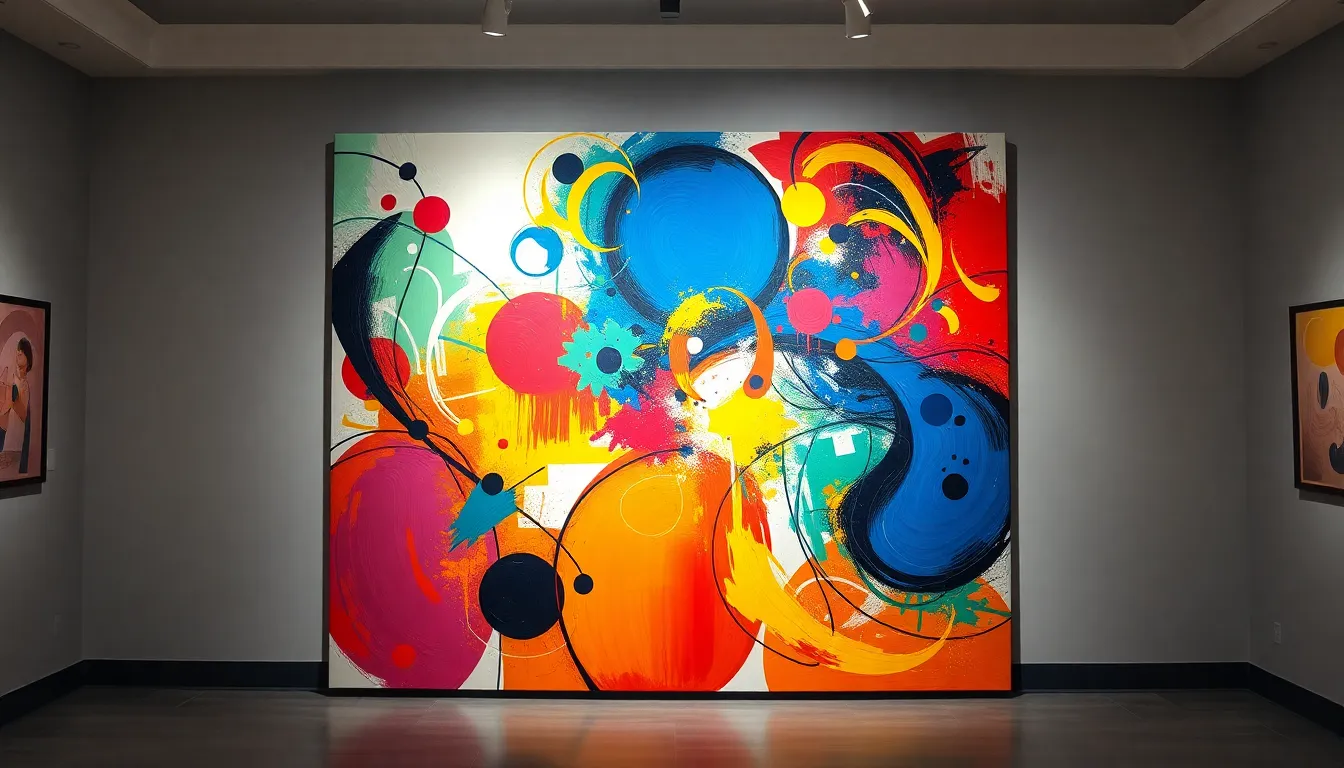Abstract art styles are like that mysterious friend who always keeps you guessing. They challenge the norms of traditional art, inviting viewers into a world where shapes, colors, and emotions collide in a delightful chaos. Whether it’s the bold strokes of expressionism or the playful forms of geometric abstraction, these styles offer a refreshing escape from reality.
Abstract Art Styles
Abstract art emerges in various forms, showcasing a departure from traditional representation. It encompasses styles that prioritize emotions and concepts over realistic portrayals. Notable styles within abstract art include expressionism, which emphasizes emotional experience, and geometric abstraction, focusing on shapes and colors.
Expressionism often features bold colors and dynamic forms. Artists express personal feelings, drawing viewers into their emotional landscape. The movement gained prominence in the early 20th century, driven by artists like Edvard Munch and Wassily Kandinsky.
Geometric abstraction, on the other hand, relies on simplified forms and clean lines. Artists such as Piet Mondrian and Kazimir Malevich championed this style, creating visually striking pieces. Shapes and colors interact harmoniously, challenging perceptions and evoking different interpretations.
Color field painting represents another significant style within abstract art. This approach emphasizes large areas of color and minimal shapes. Mark Rothko and Barnett Newman are prominent figures associated with this technique, creating works that encourage deep contemplation and emotional response.
Additionally, lyrical abstraction combines free-flowing forms with vibrant colors. This style often expresses spontaneity and movement, resonating with the viewer on a sensory level. Artists like Joan Mitchell and Helen Frankenthaler exemplify this style, creating works that capture emotion through fluid brushwork.
Each abstract art style approaches artistic expression differently, yet all share a common goal of evoking thought and emotion. As viewers engage with these varied forms, they experience a unique journey into the realm of visual language devoid of traditional constraints.
Major Abstract Art Styles

Abstract art consists of several distinctive styles. Each style reflects unique methods of expression that challenge traditional representation.
Geometric Abstraction
Geometric abstraction, characterized by simplified shapes and structured forms, emphasizes the relationship between colors and forms. Artists evoke clarity and precision through the use of lines, circles, and squares. Notable figures include Piet Mondrian, who utilized primary colors and a grid format, and Kazimir Malevich, known for the iconic Black Square. This style prioritizes the arrangement of shapes as a visual language, compelling viewers to engage with underlying mathematical structures.
Abstract Expressionism
Abstract expressionism stands out through its emotional intensity and spontaneous approach. Artists utilize bold colors and dynamic brushwork to convey feelings and ideas rather than represent objects. Jackson Pollock’s drip paintings exemplify this style, encouraging viewers to experience movement and sensation. The focus lies on the act of creation itself, manifesting visceral reactions and inviting deep introspection. Each painting serves as an exploration of the artist’s psyche, creating an emotional connection with the audience.
Color Field Painting
Color field painting emphasizes the use of large, flat areas of color to evoke emotion and contemplation. Artists such as Mark Rothko utilize soft edges and expansive canvases to create contemplative spaces, encouraging viewers to lose themselves in layers of color. This style relies heavily on the psychological effects of color and seeks to elicit a response through visual immersion. Simplicity and purity form the foundation, allowing color to dominate the experience and resonate deeply.
Minimalism
Minimalism strips away complexity to focus on essentials, emphasizing simplicity and function. Form and material take precedence, with artists like Donald Judd using geometric shapes and industrial materials to create object-like sculptures. The clean lines and unadorned surfaces invite viewers to appreciate the beauty of the ordinary. Each piece engages viewers by provoking thought on the relationship between space and perception. This style advocates for clarity in art, encouraging a direct and unmediated experience.
Influential Artists in Abstract Art
Abstract art thrives on the creativity of visionary artists who push boundaries within artistic expression. Several key figures have significantly shaped its evolution.
Wassily Kandinsky
Wassily Kandinsky is often regarded as a pioneer of abstract art. He emphasized the emotional power of color and form. Kandinsky believed that art could transcend the physical world, seeking to evoke feelings through abstract compositions. His works, like “Composition VII,” feature vibrant colors and dynamic shapes, reflecting his belief in the connection between art and spirituality. This artist’s use of color theory and shapes inspires many contemporary abstract artists today.
Piet Mondrian
Piet Mondrian revolutionized abstract art with his geometric approach. He focused on simple shapes, particularly squares and rectangles, using bold colors and black lines. Mondrian’s iconic work, “Composition with Red, Blue, and Yellow,” highlights his philosophy of reducing art to its essentials. Clarity and harmony became central to his style, allowing viewers to experience balance within his compositions. His contributions laid the groundwork for future movements, influencing minimalism and modern design.
Jackson Pollock
Jackson Pollock brought a new level of spontaneity to abstract art through his drip painting technique. He engaged in action painting, allowing paint to flow freely onto the canvas. Pollock’s famous work, “No. 5, 1948,” exemplifies this method and invites viewers into an energetic dialogue with the artwork. His dynamic brushwork and layered paint create a sense of movement and depth, emphasizing the act of creation itself. This artist’s approach profoundly impacted abstract expressionism, encouraging artists to explore their own methods of artistic expression.
The Evolution of Abstract Art
Abstract art has journeyed through various phases, reflecting cultural shifts and innovations. It continually adapts to the changing landscape of artistic expression.
Historical Context
Early 20th-century movements marked the birth of abstract art, challenging traditional representations. Artists like Wassily Kandinsky and Kazimir Malevich laid foundational ideas, promoting emotions over realism. The 1910s saw the emergence of geometric abstraction, emphasizing shapes and forms in pieces like Malevich’s “Black Square.” Expressionism followed, prioritizing powerful emotions depicted through bold colors and dynamic forms. World events influenced these shifts, with the aftermath of World War I fueling a desire for new artistic directions. By the end of the century, abstract art had evolved into various styles, each building upon the past while introducing new concepts and techniques.
Contemporary Trends
Contemporary abstract art embraces a diverse range of styles and mediums, reflecting today’s global society. Artists often blend traditional techniques with digital practices, exploring unique visual languages. Styles like post-abstract expressionism and lyrical abstraction remain prominent, emphasizing spontaneity and emotional depth. Installation art has gained traction, allowing artists to create immersive experiences of abstract concepts. Additionally, social and political influences increasingly shape modern works, as artists address issues like identity, technology, and environmental concerns. This fusion of ideas encourages viewers to engage deeply and contemplate the evolving nature of abstract art within a contemporary framework.
Conclusion
Abstract art styles offer a vibrant exploration of creativity that challenges conventional perceptions. By prioritizing emotion and concept over realism, these styles invite viewers into a world where imagination reigns. From the bold expressions of color field painting to the structured elegance of geometric abstraction, each approach provides a unique lens through which to experience art.
The influence of groundbreaking artists continues to resonate today as contemporary creators push boundaries and explore new mediums. As society evolves, so does abstract art, reflecting cultural shifts and inspiring fresh dialogues. Engaging with these diverse styles encourages a deeper appreciation for the power of visual language and the profound connections it fosters.

